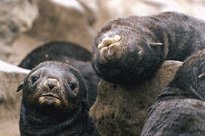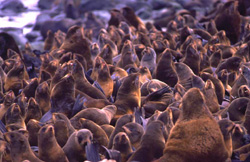Northern Fur Seal
(Callorhinus ursinus)
IUCN STATUS (2010) - VULNERABLE
| Distribution and Numbers The Northern fur seal is found throughout the north Pacific Ocean, ranging from the Bering Sea down to southern California in the east and to central Japan in the west. Almost three quarters of the total population, about 1 million fur seals, breed on the Pribilof Islands of St. George and St. Paul in the southern Bering Sea. Other breeding sites are found on the central Kuril Islands (50,000 - 55,000), Tyuleniy Island in the Okhotsk Sea (55,000 - 65,000), the Commander Islands (225,000 - 230,000), Bogoslof Island in the Aleutian Islands (5,000), and San Miguel Island in southern California (4,300). The total world population is estimated at 1,345,000 - 1,365,000. |
| Status Northern fur seals have been subjected to a great deal of intensive commercial hunting for their fur, many millions of the seals being killed following the discovery of the species in the 1700s. Such hunting, particularly unregulated hunting at sea, heavily reduced the population in the 19th and early 20th centuries and resulted in the signing in 1911 of the North Pacific Fur Seal Convention by the US, Japan, Russia and the UK (for Canada). Among other provisions, the Convention banned the hunting of Northern fur seals at sea and restricted the killing on land to immature males. An experimental hunt of females from 1956-1968 was also intended to stimulate productivity but contributed to a population decline of 6-8% per year from 1975 to 1982. |
 Photo: Phillip Colla, Phillip Colla Wildlife Photography |
| The commercial hunting of immature male fur seals was discontinued on St. George Island in 1973 and on St. Paul Island in 1984, the year that the Convention lapsed. The population has remained fairly stable since the early 1980s but is about half the size it was during the 1950s. Lack of an international agreement means that the possibility of the hunting of Northern fur seals at sea in the future cannot be ruled out. Juvenile male fur seals are still killed by Aleut natives on St. George and St. Paul Islands for subsistence purposes, 232 and 1,588 seals being killed on the respective islands in 1996. Fur seals are not killed on Bogoslof Island or San Miguel Island but it is thought that 0.2-2% of the population on the Asian islands are killed each year, including 1,500 males on Tyuleniy Island and 5,000 pups on the Commander Islands. The fur seals killed by Aleut natives on the Commander Islands are used to produce fur products and meat for fur farms. |
 Photo: Rolf Ream, National Marine Mammal Laboratory |
The commercial fishing of Northern fur seal prey, primarily walleye pollock, in the Bering Sea is of concern. There was an estimated mortality of 5,200 Northern fur seals due to entanglement in the high seas driftnet fisheries in 1991 but these fisheries have now been discontinued. However Northern fur seals are still commonly caught by the Japanese squid driftnet fishery and a small number of seals are entangled in Alaskan gillnet and trawl fisheries. There is also concern that the Northern fur seal population on the Pribilof Islands may be being negatively affected by pollution and disturbance caused by the expansion of fishing industry support services on St. Paul Island. |
| It has recently been reported that the waters off the Russian Sakhalin Island in the Okhotsk Sea are about to be opened to massive oil and gas development, and that tanker traffic and the extreme weather conditions in the area may lead to a major spill, affecting the important Northern fur seal breeding site on nearby Tyuleniy Island. Oil exploitation elsewhere in the species' range may also result in disturbance or pollution. |
| Studies in the Pribilof Islands have found that a significant number of fur seals become entangled in marine debris, mainly pieces of trawl net, plastic packing bands and loops of synthetic or natural twine. Juvenile males appear to have a significantly higher rate of entanglement than adult males and females. Mortality from entanglement may have been a contributing factor in the decline of the Pribilof Islands population in the 1970s and early 1980s, but this source of mortality decreased in the late 1980s and early 1990s and is now at about half the rate observed during the decline. The San Miguel population, which primarily originated from animals born on the Pribilof Islands during the late 1950s or early 1960s, is very sensitive to decreases in prey caused by El Nino events. Up to 87% of the pups born at the colony in 1997 during the 1997-98 El Nino died before weaning and it may take the population several years to recover. |
| The Northern fur seal is listed as Vulnerable on the IUCN Red List, and the Pribilof Islands / Bogoslof Island stock is designated as Depleted under the U.S. Marine Mammal Protection Act. The species is protected in Canada by the 1993 Marine Mammal Regulations, except for hunting by indigenous peoples. |
| Lifestyle Breeding rookeries are generally near the continental slope and are usually rocky. Showing strong fidelity to specific sites, the adult males start arriving at the rookeries in May to establish territories that can eventually contain many females. The females start arriving in mid-June and give birth within 2 days of arrival. Pups are born with a black coat. The mother nurses her pup for 8-10 days, usually mating about 5-6 days after her pup's birth, and then leaves to feed at sea, usually feeding at night to average depths of 68m for an average of 2-3 minutes. This begins a cycle of feeding at sea for 4-10 days and returning to nurse her pup for 1-2 days, the cycle lasting for about 4 months until the pup is weaned and the mother leaves to migrate south. Call recognition is essential for mothers and pups to locate each other during the nursing period, a research study in an Alaskan breeding colony showing that mothers and their offspring were still able to recognise each other by their calls after four years of separation. The adult males remain ashore while defending their territory during the breeding season and lose up to 20% of their weight since they do not eat during this time. |
| Adult females normally migrate south in late October - November. Some adult males start their migration in August while others stay on shore until as late as November. On migrating south, Northern fur seals spend the next 6-8 months at sea. Adult males from the Pribilof Islands generally only migrate as far south as the Gulf of Alaska, some remaining in the Bering Sea, while females and juveniles from the Pribilof Islands migrate to offshore waters along the continental shelf from Canada down to California. Females and juveniles in the west migrate as far south as Japan. Individuals are sometimes seen in inshore waters while stragglers occasionally come ashore. Many pups remain at sea for up to 22 months before returning to the breeding islands, very often to the haulouts surrounding the rookery where they were born. |  Photo: National Marine Mammal Laboratory |
| Adult males are usually brownish-grey but can be reddish-brown or black, while adult females have a silvery-grey back and reddish-brown front with a whitish-grey patch on the chest. Walleye pollock and squid are the most important Northern fur seal prey during the summer while the population is in the Bering Sea, but they are also known to feed to a lesser extent on sand lance, salmon, capelin, herring, mackerel, hake, anchovy and other fish. Predators include sharks, foxes, killer whales and Steller sea lions. |
Statistics
Adult male Northern fur seals measure an average of 2.1m in length and weigh 175-275kg, while females are smaller at an average 1.4m in length and 30-50kg. Pups are born measuring about 60cm, the males at an average of 5.4kg weighing more than the females at 4.5kg. Pup mortality in the first year is about 50%. Females reach sexual maturity at 2-5 years, males at 4-5 years, although males do not start breeding before they are about 8-9 years. The adult male reproductive peak is brief and few adult males breed for more than two seasons. The maximum recorded dive depth of a Northern fur seal is 230m. Northern fur seals can live up to about 25 years of age but have a life expectancy at birth of less than 4 years.
